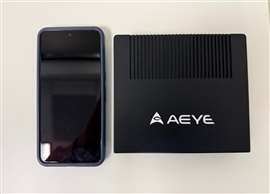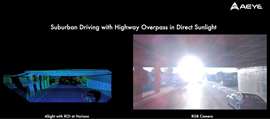AEye debuts compact, high-range Lidar for Class 8 autonomy
02 April 2025
Considering that a fully loaded Class 8 tractor-trailer can legally weigh as much as 80,000 lb. in the United States, bringing the vehicle to a stop from highway speeds can require 200 – 300 ft. or more. This depends, of course, upon a variety of assumptions, including the driver’s reaction speed. That’s arguably why the American Association of Motor Vehicle Administrators’ (AAMVA) commercial driver license (CDL) manual recommends that good drivers look 12 – 15 seconds ahead of the vehicle, or about a quarter mile at highway speed.
Stopping such a heavy vehicle traveling so fast, such as in the case of an unforeseen obstacle, is a significant challenge in autonomous trucking. One way obstacle detection is being addressed is via light detection and ranging (Lidar) technology.
“Out on highways, where you have heavy metal driving out there, you really need to see far ahead at 60, 70, 80 mph even to avoid a panic braking or stopping situation,” said Matt Fisch, chairman and CEO for AEye, a California-based Lidar solution provider for vehicles and smart infrastructure.
AEye has been developing its latest generation Lidar sensor — Apollo — since 2024 and presented the product to the market at CES 2025. The company recently achieved a milestone in which the Apollo Lidar was able to detect objects at a distance of 1 km during field trials, something the company believes to be an industry first.
Compact Design
 Not much bigger than a cell phone, Apollo’s small form factor offers OEMs strong design flexibility. (Photo: AEye)
Not much bigger than a cell phone, Apollo’s small form factor offers OEMs strong design flexibility. (Photo: AEye)
“We have a very unique architecture in this,” Fisch said, adding that unlike the videocassette recorder (VCR)-sized Lidar sensor hardware currently on the market, AEye’s Apollo is about the length and width of a cell phone. For Class 8 tractors, that allows it to be more easily installed behind the windshield, on the roof or behind the grille.
Despite its small footprint, Fisch said AEye’s architecture also allows for the use of lenses larger than those typically used in the industry — one reason for the 1 km detection distance.
Fisch explained that the company’s Lidar works by sending out a pulsed laser beam to both detect obstacles in front of the vehicle and identify what the obstacles are.
“There’s a car ahead, or this is a hazard that’s distinct from the ground,” he said. “Somebody dropped a tire off a truck [for example], and you need to do something about it.”
Benefits Over Cameras
Because Lidar by definition provides its own light source in the form of a laser, it offers some advantages over traditional cameras.
“Number one, we can see in the dark,” Fisch said. “We can also see a lot better in bad weather than a camera.”
Additionally, Lidar is not confused by bright external light sources, such as the sun. Fisch shared a sun-related problem an automotive OEM had regarding its camera-based advanced driver assistance system (ADAS).
 Both photos were taken simultaneously, at the same location and time of day. On the left is the AEye Lidar image, and on the right is a traditional camera image. This illustrates Lidar’s ability to avoid issues detecting objects in bright sunlight. (Image: AEye)
Both photos were taken simultaneously, at the same location and time of day. On the left is the AEye Lidar image, and on the right is a traditional camera image. This illustrates Lidar’s ability to avoid issues detecting objects in bright sunlight. (Image: AEye)
“They were getting a lot of complaints about their car suddenly braking for no reason — panic stopping,” Fisch said. The location and time of day was at an overpass during which the sun would shine directly at the vehicle.
“You have the sun shining in, and the car thinks it’s going to crash into the sun and slams on the brakes,” Fisch said.
Lidar, by comparison, is not confused by bright lights such as the sun.
“We ignore it if it’s not a reflection that’s coming back from our laser scanner,” he said. “And there are thousands of these kinds of situations in driving.”
In addition to the Apollo sensing hardware, there is an external software stack that provides the system’s intelligence.
“It’s usually some kind of graphics module, CPU, that does sit physically close by, on the edge, generally,” Fisch said. “But it generally runs separately because our understanding of objects and things like that changes so quickly. You don’t want to be updating your hardware every day or every few weeks.”
Fisch added that AEye is integrated with NVIDIA Drive software solutions for autonomous vehicles.
AEye Advancing AI?
While the company’s name is a play on the acronym for artificial intelligence, it is AI that allows the system to identify the objects it encounters. Fisch said that AEye’s Lidar solution in fact takes AI to a new level.
He explained that traditional image searching, such as that done via Google, is about simple pattern recognition. AEye’s Lidar goes beyond that.
“Lidar enables a new level of artificial intelligence,” Fisch said. “It actually allows more of that thinking side, if you will, because it’s not looking for patterns. It’s actually telling you whether something is there or not, because it can see in three dimensions.”
He added, “Lidar not only sees an image, if you will — it looks a little different than a camera image — it sees and it knows how far away it is. It knows how fast the object is moving, and it knows whether the object is part of the road — if it’s a manhole cover or if it’s actually something that’s sticking up enough for you to crash into.”
Smart City Applications
AEye’s Lidar has other applications, both in transportation and as part of smart city infrastructure.
“One of the things you’ll notice on the news lately is a lot of incidents at airports,” Fisch said, such as parts falling from aircraft to the tarmac.
“You have to get people to drive around — they try to look for things that are on the tarmac so they don’t get sucked into a jet engine,” he added. “Lidar allows you to see very small objects — our Lidar in particular.”
Another hot topic Fisch mentioned is intelligent traffic systems.
“We have some of these sitting at intersections,” he said. “They’re sending data to DOT organizations that say here’s how congested an intersection is. It’s difficult for a camera to track 30 cars moving at the same time, making left and right turns. Oh, did they blow a red light? Did they make an illegal U-turn?”
Security is another application.
“If you have an intruder — you have somebody flying a drone into an area that you don’t like,” Fisch said. “Drones are very small. Radar doesn’t pick them up very easily. This [Lidar] is your device of security and safety in that regard.”
Regarding the future of AEye’s investments in its technology, such as the potential for detecting objects beyond 1 km, Fisch said that it will be driven by OEM needs.
“We think a kilometer gives a heck of a lot of headroom for the next few years,” he said. “The OEMs view that as a budget. But there are other applications, like trains, that take even longer than trucks to stop. There are defense applications that are starting to hit the news as you see drone incursions. They’re not saying a kilometer is too far. There always seems to be this hunger for more horsepower.”
POWER SOURCING GUIDE
The trusted reference and buyer’s guide for 83 years
The original “desktop search engine,” guiding nearly 10,000 users in more than 90 countries it is the primary reference for specifications and details on all the components that go into engine systems.
Visit Now
STAY CONNECTED




Receive the information you need when you need it through our world-leading magazines, newsletters and daily briefings.
CONNECT WITH THE TEAM









